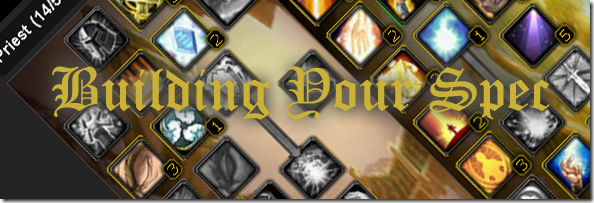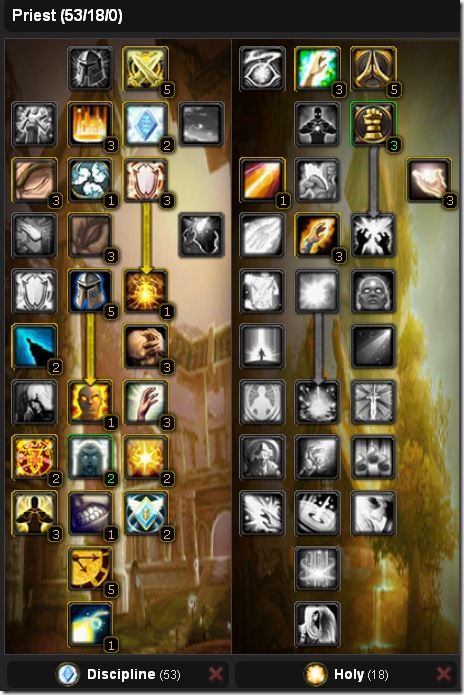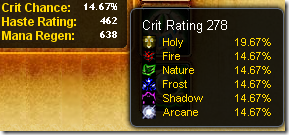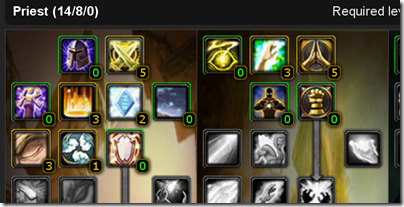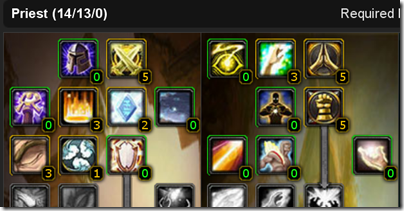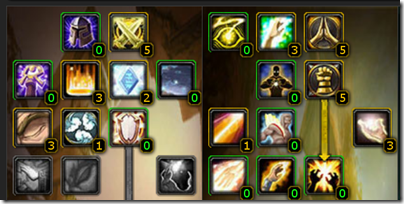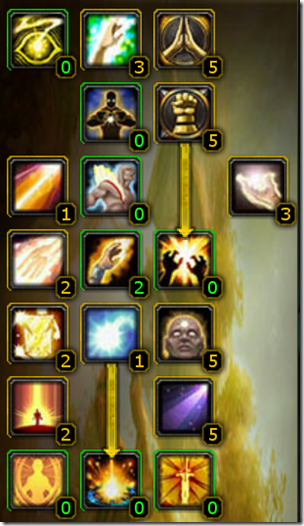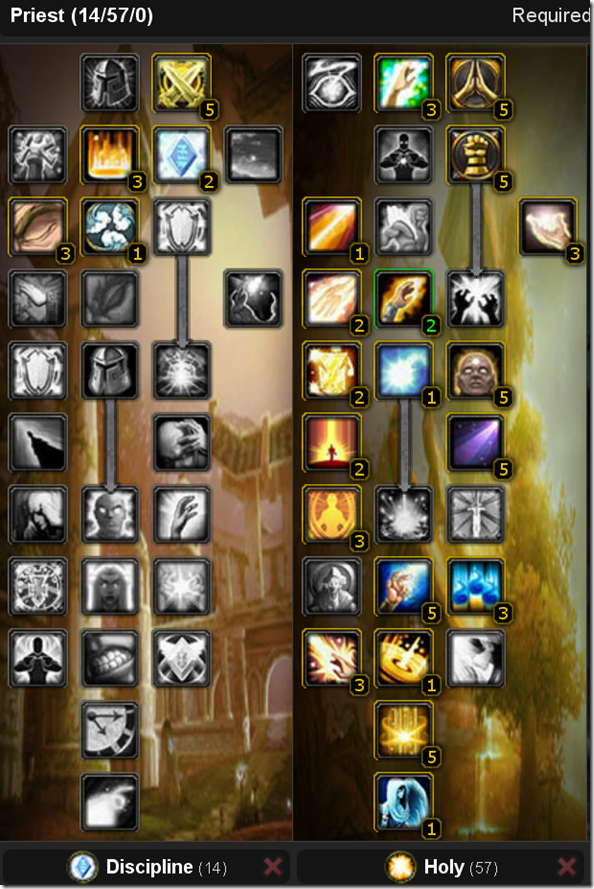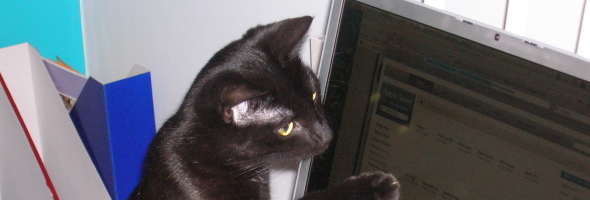Okay, you waited patiently for this, and a few of you kept poking me to make sure it got done. I hope I made you proud!
Part 1 gave a brief overview of each talent.
Part 2 went through my Holy spec, and how you can customize it for your needs.
This installment will review my Discipline spec, which is NOT a cookie-cutter build.
Step 1: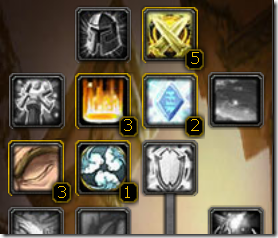
To start, plug in those mandatory 14 points:
- Twin Disciplines – 5
- Improved Inner Fire – 3
- Improved Power Word: Fortitude – 2* **
- Meditation – 3
- Inner Focus – 1
*PvEers: If you are 100% certain that another Priest in your raid will have Imp:Fort, and not mind buffing, and you REALLY feel the need for threat reduction, you can move these two points into Silent Resolve. I don’t think it’s worth it, but it is an option.
**PvPers: Choose Martyrdom rather than Imp:Fort.
Step 2:
Decide whether this is a Holy build, or a Discipline build. For this example, I’ll walk you through my Disc spec and my reasons for each point. This will be a bit different: because I usually raid Holy, my Holy build is very utilitarian. My Disc build, on the other hand, is specifically for General Vezax Hardmode – the only 25-man fight where I use it. (I do use it in 10 man content for things like Iron Council hardmode, but due to gearing levels, the spec doesn’t need to be perfect to handle the fight.)
Step 3:
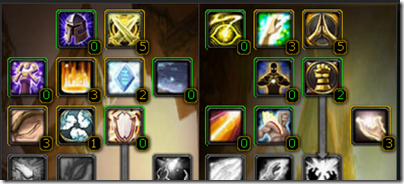 Because this is a Disc build, and Disc builds focus on single target or tank healing, after plugging in the mandatory points in the Disc tree, we should flip over to Holy, since we KNOW that we will want Inspiration, and get those points out of the way. This will give a better idea of how many points we have to work with when we are making either-or decisions deep in the Disc tree itself.
Because this is a Disc build, and Disc builds focus on single target or tank healing, after plugging in the mandatory points in the Disc tree, we should flip over to Holy, since we KNOW that we will want Inspiration, and get those points out of the way. This will give a better idea of how many points we have to work with when we are making either-or decisions deep in the Disc tree itself.
The first step is to max out Holy Specialization – I do this in Holy to allow more Haste on my gear, but in Discipline because of how Crit is heavily favored by deeper Discipline talents. Next, because I personally use Renew rather heavily to even out spiking tank damage, I max out Improved Renew.
I do not use Greater Heal often, so I only put 2 points in Divine Fury for now – I prefer that my Greater Heals be slightly faster when I DO need them (and, remember, I’m very used to a LOT of haste – I generally have over 15%). I have considered removing these points from Divine Fury altogether and moving them into Healing Focus – But, again, because this build is specifically for General Vezax, none of the damage causes spell pushback. You could make a case for putting these points into Spell Warding, but because of how Saronite Vapors works, as you decrease your taken damage, you will also decrease your mana received. (Note: Saronite Vapors are only available on regular mode) If you have trouble getting out of the vapors before the 8th tick, or want some cushion for the 7th, 2 points in Spell Warding might be a great idea. Whether you decide to put these points into Healing Focus, Divine Fury, or Spell Warding, leave it at two – that’s all you need to get to the next tier. If you find yourself with extra points after we’re done on the Disc side, you can always come back and plug them in.
Getting to the next tier is critical, since that’s where Inspiration is. Max it out, and go back to the Disc tree.
Step 4:
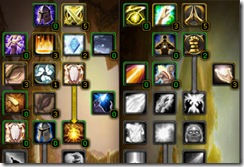 So far, with the exception of limiting the points in Divine Fury to two, this looks exactly like a Holy build. Which makes it time to plug points in down the Disc tree. We already took the Mandatory 14 points in Step 1, so we’ll move forward from the 3rd tier. We already maxed out Meditation and Inner Focus, so just pick up all 3 points in Improved Power Word: Shield – the bread & butter spell of a Disc Priest – now even better!
So far, with the exception of limiting the points in Divine Fury to two, this looks exactly like a Holy build. Which makes it time to plug points in down the Disc tree. We already took the Mandatory 14 points in Step 1, so we’ll move forward from the 3rd tier. We already maxed out Meditation and Inner Focus, so just pick up all 3 points in Improved Power Word: Shield – the bread & butter spell of a Disc Priest – now even better!
In the 4th tier, 3 points in Mental Agility is all you need to move on to the 5th tier. Many, many Priests who take Disc as a career option will also want to pick up Absolution – invaluable on fights that involve crazy amounts of dispelling like Hodir Hardmode, Thorim Hardmode, and Yogg Saron. Because my disc build is for General Vezax specifically, and Vezax involves zero dispelling, I skip it. You do not, for any reason, need Improved Mana Burn in a PvE build.
Tier 5 gives us Mental Strength, a must not only for better mana pool and increased regen from replenishment, but you have to max this out in order to access Power Infusion. To the right is Soul Warding, your reward for maxing out Improved Power Word: Shield. Since Reflective Shield, on the left, only causes damage to those attacking you, the Priest, it’s pretty much useless for PvE. (It reminds me a bit of the old Human Priest racial Feedback – I never used that, either, but at least this doesn’t cost extra mana and only last for 10 seconds.)
Next, max out both Focused Power (to increase your healing done), and Enlightenment. For Vezax, you could actually skip Elnlightenment – the Spirit isn’t going to give you any regen, and without Spiritual Guidance from the Holy tree, you won’t see a bonus to your spell power, either. But, personally, I appreciate the increase to haste, so I take it. (You have to have these points somewhere, anyway, to be able to unlock the next tiers.)
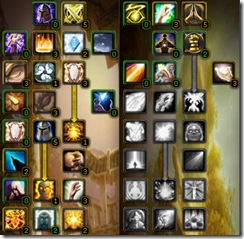 Tier 7 allows you to skip Focused will – the increased crit chance notwithstanding, this is primarily a PvP talent, and the bulk of it is useless for PvE. Power Infusion, on the other hand, is a brilliant talent. I don’t use it on myself on Vezax HM, since the mana cost isn’t offset by my own casts (I’m not chain casting.), but I’ll toss it on a Mage or Ele Shaman if I have spare mana. Having this talent allows my very specialized spec to do double duty in 10 mans. I do max out Improved Flash Heal – especially now that they cooldown on Penance is longer, I find I sometimes need Flash Heals to top off the tank.
Tier 7 allows you to skip Focused will – the increased crit chance notwithstanding, this is primarily a PvP talent, and the bulk of it is useless for PvE. Power Infusion, on the other hand, is a brilliant talent. I don’t use it on myself on Vezax HM, since the mana cost isn’t offset by my own casts (I’m not chain casting.), but I’ll toss it on a Mage or Ele Shaman if I have spare mana. Having this talent allows my very specialized spec to do double duty in 10 mans. I do max out Improved Flash Heal – especially now that they cooldown on Penance is longer, I find I sometimes need Flash Heals to top off the tank.
Tier 8 gives us one of the greatest talents in the Disc Priest arsenal – Renewed Hope. I had a Disc Priest try to tell me that PW:S wasn’t worth the mana on Vezax – that it didn’t absorb enough. (I know, right?) Even if it didn’t, the increased crit to Penance, Flash, and Greater Heal, and the chance to reduce damage on this tank by 3% is unbelievable. Rapture is where my spec gets a little strange. I only take 2 points here. 1 of them is to open the next tier, and the other could be moved somewhere else. The thing is that Rapture, while amazing on fights that actually allow regen, doesn’t work on Vezax. I’ve heard conflicting reports that it DOES work on your target, but not you, the caster. Either way, my tank is far, far, far from rage /runic power starved, and if I can’t get any mana back, who cares. I’ll show you what I do with the extra point later. Aspiration is useful for lowering the cooldown not only of Penance, but of Inner Focus. Max max max.
 Max out the whole of Tiers 9, 10, and 11. Not that you need specific reasons, but on tank-damage-heavy fights like Vezax, an additional shield, external, tank-saving cooldown, and additional healing received are HUGE. Ditto for a 40%-of-your-spellpower-bigger PW:S, spellhaste, and the grandaddy Disc Healing spell of them all, Penance. Nom, Nom, Nom.
Max out the whole of Tiers 9, 10, and 11. Not that you need specific reasons, but on tank-damage-heavy fights like Vezax, an additional shield, external, tank-saving cooldown, and additional healing received are HUGE. Ditto for a 40%-of-your-spellpower-bigger PW:S, spellhaste, and the grandaddy Disc Healing spell of them all, Penance. Nom, Nom, Nom.
Okay, so you can see that we now have 53 points in Disc, and if you’ve been following along in the holy tree, you’ll have 13 spent there. This leaves 5 points. Go over to the Holy Tree. In the middle of tier 4 is Improved Healing, which reduces the mana cost of Greater Heal, Divine Hymn, Penance, and some junk we don’t care about. For a fight like Vezax, this is huge. To get there, I take Desperate Prayer, mostly because I’m so used to having it (and bad things seem to happen to me when I don’t.) and I add one more point into Divine Fury. Again, these are purely based on my personal playstyle, and you could pack those two points into Healing Focus or Spell Warding – I just haven’t found either of those talents as useful as extra haste for my biggest heal, and an “Oh Sh**!!” button for myself.
Once those points are assigned, traipse down to Improved Healing and max it out – this reduces the mana cost of your Penance by 15% – roughly 93 mana saved, per cast. THIS is why I shaved the point out of Rapture, and why my Disc spec is considered pretty unorthodox. I wouldn’t spec this way if Disc were my primary spec, but for Vezax, Vezax HM, and any 10 man content (where my gear can compensate for a non-ideal spec), it’s brilliant.
This is my completed spec:
Which, again, is very, very specialized, and not at all what I would call a “typical” Disc spec. Part of my hesitation in writing this post is that I know most of our commenters and community are very vigilant about watching for things to be “best” and also about making a very strong case for their own quirks – but that’s the thing about WoW as it stands currently – “best” is dependent upon playstyle, which is itself dependent upon available content/equipment. That said, sometimes there really IS a “better” if not a “best” way to do something, and the fastest way to figure out what that is is to throw yourself into the lovely group of people that make the healer community.
I hope this look at a non-standard build helps you feel more comfortable stepping outside the box and tailoring your own spec to your specific needs – feel free to discuss what you’ve found helpful in the comments.
Next Post: Helpful Macros (keep me honest on this one – I’m terrible about posting most of the time, but I always read your emails, and your encouragement makes a huge difference!)
Luv,
Wyn
